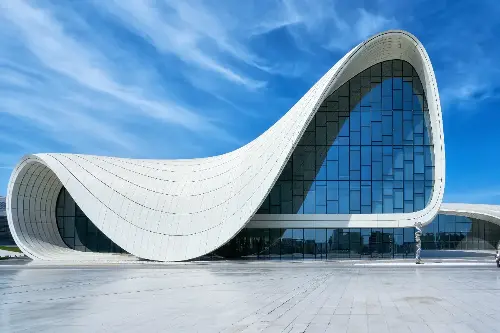From Steel to Splendour: Unveiling the Top 5 Modern Architectural Masterpieces Elevating Cityscapes Worldwide
The artistry of architecture is a testament to human creativity and engineering. It’s a medium where practicality meets extravagance, culminating in spaces that are not just structures but experiences. Over the years, architects around the globe have pushed the envelope, crafting buildings that challenge perceptions and elevate cityscapes. Let’s journey through the corridors of modern marvels to unveil the top five architectural masterpieces gracing our cities today.
The Canvas of Innovation: The Guggenheim Museum Bilbao
Nestled in the heart of Spain’s Basque Country, the Guggenheim Museum Bilbao, designed by Frank Gehry, is a spectacular ode to 20th-century architecture. Since its inception in 1997, the museum has become synonymous with Bilbao, invigorating the city’s identity. Gehry’s deconstructivism is evident in tangled steel and shimmering titanium that resembles a ship afloat, paying homage to Bilbao’s maritime heritage.
The museum’s dynamic design is complemented by advanced engineering techniques. Supported by a computer-aided 3D system, Gehry crafted a structure that subverts conventional architectural lines, creating an interplay of forms that appear to shift when viewed from different angles. It’s not only a marvel from the outside; the interior is equally mesmerising with its expansive atrium that boasts curved walkways, suspended platforms, and voluminous galleries that house iconic works of contemporary art.
An Apex of Ecological Design: Gardens by the Bay
Singapore is a city that prides itself on harmonising urban life with natural splendor, and nothing encapsulates this more than Gardens by the Bay. Designed by Grant Associates and Wilkinson Eyre Architects, this futuristic park spans 101 hectares with its famed Supertree Grove, Flower Dome, and Cloud Forest.
What sets Gardens by the Bay apart is not just its otherworldly appearance, but the ecologically sustainable cycle that operates beneath its verdure. The towering Supertrees, for instance, mimic real trees not just in form but function. They harness solar energy, collect rainwater, and act as venting ducts for the conservatories, forming an ecosystem within the technological marvel. These structures, combined with the climate-controlled biomes, serve as a model for ecological design, emphasising the possibility of a symbiotic relationship between nature and urban environments.
Reshaping Skylines: Burj Khalifa
At a towering 828 metres, Dubai’s Burj Khalifa not only reshapes the city’s skyline but also the record books, holding the title of the world’s tallest building since 2010. The brainchild of architect Adrian Smith, then of Skidmore, Owings & Merrill, this skyscraper’s Y-shaped plan ensures maximum panoramic views for residents and stabilises the structure.
The Burj Khalifa is an architectural embodiment of Dubai’s lavish spirit. Its triple-lobed footprint is inspired by the desert flower Hymenocallis – a motif that echoes throughout the tower. This megatall building employs a buttressed core system, which supports the monumental height and combats the forces of wind and weight. It’s a vertically organised city with residences, offices, and the Armani Hotel Dubai, representing a pinnacle in skyscraper engineering.
Elegance Personified: The Shard
London’s urban tapestry weaves together history and modernity, and The Shard stands tall as a testament to this blend. Renzo Piano envisioned a ‘vertical city’ and brought it to life in the form of Europe’s tallest building until 2017. Its façade of angled glass reflects the city’s temperament, changing moods with the sky’s canvas – sometimes disappearing entirely into London’s fickle weather.
Sustainability was key in Piano’s design philosophy; rainwater recycling, natural ventilation systems, and combined heat and power plants are part of its operational ecosystem. The Shard, akin to a crystalline spire, doesn’t just scrape the sky; it graces it, a pinnacle of 21st-century sophistication.
Bold Curves: Heydar Aliyev Centre
The Heydar Aliyev Centre in Baku, Azerbaijan, reflects the cultural shift of a nation from its Soviet past towards modernity. Zaha Hadid, known for her neofuturistic design, ensured that the building became a flowing manifestation of the progressive spirit of Baku. With no sharp angles within its walls, the centre presents an undulating silhouette that naturally arises from the folds of its geometric landscape.
Constructed using space frame technology and glass-fibre-reinforced polyester panels, the centre seems to defy gravity. Functionality merges with form within its interiors that house an auditorium, gallery halls, and a museum. Its seamless curves are not just a visual treat but an audacious step in architectural fabrications, displaying how boundaries in design are mere guidelines waiting to be transcended.
Intricately designed, these architectural masterpieces do more than dot the globe with their presence. They challenge our understanding of the spaces we occupy, merging aesthetics with advanced engineering to create an enduring legacy. Whether revitalising a city’s image, forging a relationship with nature, or quite literally, reaching for the stars, these marvels represent the zenith of human aspiration manifested in steel, glass, and splendour. They remind us that architecture is not just buildings; it’s the poetry of bricks and mortar that endures and inspires across ages and cultures.
